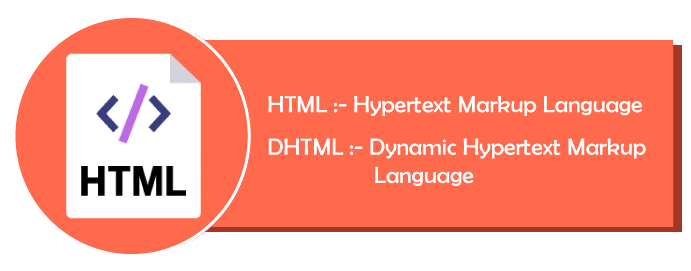Difference between HTML and DHTML
Introduction to HTML
HTML stands for Hypertext Markup Language. It is a standard web language used to create web pages and applications. HTML is used to define the structure and content of the web pages. It is also used to define the relationship between HTML elements and to specify the behavior of web pages. It can be used to develop both simple and complex web pages.

HTML is a markup language that uses tags to define the structure of web pages. It consists of elements, such as headings, paragraphs, links, images and lists, which are arranged into a hierarchical structure. HTML can be used to develop websites, applications and emails.
Writing HTML
In order to write HTML code, you must use HTML tags and attributes. HTML tags are special keywords used to define the structure and content of a webpage. Attributes are additional information that can be added to HTML elements.
HTML Editors
HTML editors are programs that allow you to write HTML code. HTML editors come in three main types: text editors, WYSIWYG (What You See Is What You Get) editors and online HTML editors. Text editors are the most basic type of HTML editor, allowing you to write HTML code manually. WYSIWYG editors make it easier to write HTML code by providing a visual representation of the webpage. Online HTML editors are web-based programs that allow you to write HTML code without installing any software.
HTML Standards
HTML is developed and maintained by the World Wide Web Consortium (W3C). The W3C develops web standards, including HTML, to ensure that web pages are developed in a consistent manner across all web browsers.
HTML Features
HTML includes features that can be used to create interactive web pages. It allows for the embedding of images, videos, audio and other multimedia content. It also supports forms, which can be used to send and receive data from the server.
HTML5
HTML5 is the latest version of HTML. It is designed to make web pages more interactive and to improve the user experience. It includes new features, such as support for audio and video playback, geolocation, offline storage and canvas drawing.
In conclusion, HTML is the language that is used to create web pages and applications. It is developed and maintained by the W3C and consists of elements and attributes. HTML editors make it easier to write code.
Introduction to DHTML
DHTML stands for Dynamic HTML. It is a collection of technologies used together to create interactive websites. It combines a variety of components, such as HTML, CSS, JavaScript, and the Document Object Model (DOM). It is an effective way to create dynamic, interactive websites that can provide users an enhanced experience.
What is DHTML?
DHTML is a combination of HTML, CSS, JavaScript, and other technologies that are used to create dynamic, interactive websites. DHTML allows developers to create web pages that are more responsive and interactive than traditional static web pages. With DHTML, developers can create interfaces that update and change in response to user interactions.
What are the Benefits of DHTML?
The use of DHTML has many potential benefits. By allowing developers to create dynamic, interactive websites that respond to user input, it can improve the overall user experience. Additionally, DHTML can make websites more visually appealing, as well as easier to use and navigate. Lastly, dynamic websites can provide users with more relevant content, based on user input and preferences.
How does DHTML Work?
DHTML works by combining HTML, CSS, JavaScript, and other technologies. HTML is used to structure the website, while CSS is used to control the appearance and formatting of the page. JavaScript allows developers to create interactive elements on the page, such as dropdown menus and forms.
Conclusion
In conclusion, DHTML is a powerful tool that can be used to create dynamic, interactive websites. By combining HTML, CSS, JavaScript, and other technologies, DHTML can provide users an enhanced experience. By allowing developers to create more dynamic websites, it can improve the overall user experience.
HTML vs DHTML
HTML is a markup language used to create web pages and applications. It is used to define the structure and layout of a webpage using elements like headers, paragraphs, lists, images, etc. It is designed to be relatively simple and straightforward, whereas DHTML (Dynamic HTML) is an extension of HTML that adds more functionality and interactivity to web pages and applications. It combines HTML, JavaScript, and CSS to create dynamic, interactive content such as animations, drop-downs, pop-ups, and more. It is more complex and requires more knowledge to use.